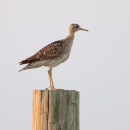Featured Species
Shawangunk Grasslands National Wildlife Refuge was established to support grassland-dependent migratory birds and wintering raptors. The refuge has been identified as a Biodiversity Focus Area and an Important Bird Area (Audubon New York), a designation given only to places that support significant abundance and diversity of birds. Many of the birds found on the refuge are included on lists of endangered, threatened, special concern or priority species, including the Short-eared Owl, Northern Harrier, Upland Sandpiper, Henslow’s Sparrow, Grasshopper Sparrow, Vesper Sparrow, Eastern Meadowlark and Bobolink.
Grassland Breeding Birds
Due to regional declines in grassland habitat availability, the refuge is becoming increasingly important for grassland breeding birds. Upland Sandpiper (a state-threatened species), Bobolink, Eastern Meadowlark, and Savannah Sparrow are commonly found nesting on refuge lands. Seasonal mowing and Prescribed burns have helped to improve the quality of the grasslands, resulting in increased observations of less common species such as Grasshopper Sparrow, Vesper Sparrow, and Henslow’s Sparrow (N.Y. state-threatened).
Wintering Raptors
The refuge provides important habitat for wintering raptors that depend upon its expansive grasslands for hunting and cover. Raptors such as the Short-eared Owl (state-endangered), Northern Harrier (state-threatened) and Rough-legged Hawk (light and dark phases) can often be found hunting the open grasslands.
Mammals
The refuge supports the occasional coyote, which depend on the quality grasslands for prey such as Meadow Voles and Eastern Cottontail Rabbits. Small mammals such as field mice, voles and shrews provide ample food for hunting raptors and snakes.
Grasslands
This refuge is managed primarily as a grassland for the benefit of grassland-dependent migratory birds and wintering raptors. Grasslands are becoming more rare as development and urbanization replace farmland across the region, and the refuge is one of only two areas within the Hudson Valley that can still support the entire assemblage of northeastern grassland birds.





